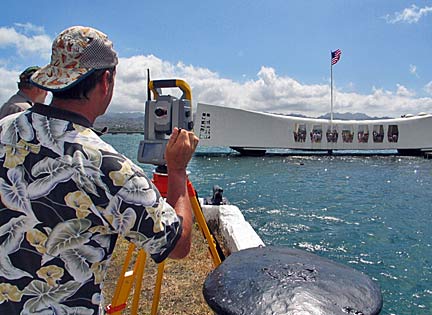
|
Program monitors memorial
Surveyors gather data to estimate
the likely life span of the slowly
deteriorating Arizona
Over the past six years, National Park Service teams have used everything from high-tech global positioning system devices to pre-World War II construction drawings to make sure the USS Arizona Memorial doesn't break up.
Few Pearl Harbor
|
The latest venture for the past week has been a $38,000 survey system donated by Trimble Corp. and the volunteer services of Les Hardy, who heads Geodimeter Southwest. A team of eight divers, national parks staff members and volunteers have been at Pearl Harbor surveying 80 feet of the Arizona's sunken deck using lasers and other methods.
The data collected, according to Douglas Lentz, USS Arizona Memorial superintendent, will be compiled with other information from the National Institute of Standards and Technology to construct a complex 3-D computer model, called a finite element model, to help predict the battleship's life span.
"That will help to determine the window when the ultimate collapse will occur," Lentz said.
The 3-D computer model will digitally reconstruct the 608-foot battleship starting from the day it was sunk by a Japanese dive bomber on Dec. 7, 1941. The effects of the fatal blast from a 1,760-pound armor-piercing bomb from one of 183 Japanese airplanes, which ignited its forward ammunition magazine sinking the battleship within nine minutes, are then factored in, along with other variables such as 60 years of immersion in salt water.
Five years ago, divers with high-powered nail guns fired 43 stainless steel nails into the ship's deck. Archaeologists and surveyors measured the longitude, latitude and elevation of each nail with GPS receivers.
This time, using sophisticated laser surveying equipment and traditional methods of measuring and mapping points on the Arizona's sunken decks, the National Park Service is updating its information.
Since the Arizona is not just a sunken warship but a maritime tomb for the remains of more than 900 sailors, officers and Marines of the battleship's 1,177 crew who were killed on the ship in 1941, the divers never go inside the hull of the vessel, said Jim Bradford, program manager for the National Park Service.
Even the white 184-foot memorial, which spans the midsection of the sunken battleship, does not touch the ship.
Instead, the park service has sent tethered, remotely controlled vehicles into the vessel and has used ultrasound on the bulkheads to measure the thickness of the hull and compare it to the original specifications.

National Park Service divers Pat Smith, left, and Matthew Russell prepared to install prisms for the laser survey system near the bow of the USS Arizona that was used to help collect data on the condition of the framework of the vessel.
Conservative estimates suggest that as much as 500,000 gallons of oil still remain in the battleship.
Brad Baker, Arizona Memorial park ranger, said, "It is critical to be able to determine as closely as possible just how long the battleship will remain intact before disintegrating and releasing oil into Pearl Harbor."
Matthew Russell, underwater archaeologist with the Park Service's Submerged Resources Center in Santa Fe, N.M, has headed the USS Arizona Preservation Project since 1999. The National Park Service has maintained a hull assessment program since 1983. Members of the USS Arizona Memorial Dive Team also conduct dives every two weeks to monitor and record the condition of several cracks on the deck of the ship, to remove objects accidentally dropped by tourists and to recover and deploy monitoring instruments.
"By the end of 2006 we hope to complete work on the research portion," Russell said, "and come up with our management resource recommendations."
Diving into the waters surrounding the Arizona over the past six years, "you see something different with each dive," Russell said.
Russell said this week he noticed "quite a bit of new sea growth and coral" clinging to the hull of the battleship.
"This could be indicative of improvement in the water quality of Pearl Harbor over the past decade," Russell added. "This might help to reduce the corrosion rate."
Jim Koza, a retired park service employee, made his first dive on Tuesday into the nearly 400 feet of murky water where the Arizona sits.
"Visibility was anywhere from five to 10 feet," said Koza, a Vietnam War Navy veteran. "Everything would change as the wind moved the waves about."
After his 5 1/2 hour dive, Koza added, "It was a just an honor to be asked to participate in this dive."
E-mail to City Desk
[News] [Business] [Features] [Sports] [Editorial] [Do It Electric!]
[Classified Ads] [Search] [Subscribe] [Info] [Letter to Editor]
[Feedback]
